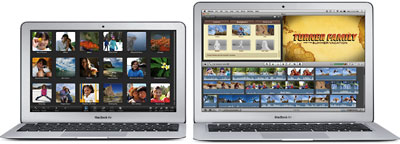Same small size, same small price, same SSD options, but a whole new CPU – and lightning-fast Thunderbolt to round things out. That pretty much summarizes the July 2011 update to the MacBook Air.
![]()
At its heart is a 1.6 GHz dual-core Intel Core i5 CPU, with a 1.8 GHz i7 version for those who need more power. Apple claims the new CPUs “do everything twice as fast” – we’ll know more when we see benchmarks for the upgraded models. That means also integrated Intel HD Graphics 3000, so say good-bye to the Nvidia GPU used in last year’s version.
A backlit keyboard is back, making it much easier to use the MacBook Air in poor lighting. Solid-state drives (SSD) are standard across the board – and they’re built right onto the motherboard. Apple claims this makes its SSDs twice as fast as conventional ones. Battery life is rated at “up to” 5 hours.
Two USB 2.0 ports (one on each side) remain standard, and the native screen resolution of 1366 x 768 is also the same as last year.

You can expand RAM from the stock 2 GB, with 4 GB as the 11.6″ MBA’s maximum (a $100 build-to-order option), and for the first time you can have Apple install a 256 GB SSD in the entry-level model.
For those who need or want a faster CPU, a 1.8 GHz i7 is a build-to-order option for the 128 GB SSD model.
The MBA has no built-in optical drive, but you can add an external USB 2.0 SuperDrive for US$79. Rather than include an install disc or flash drive, OS X 10.7 Lion includes a recovery partition.
A few things are missing. There is no FireWire port. There’s no built-in ethernet port; if you need ethernet, Apple sells a USB 2.0 ethernet adapter for $29.
The MacBook Air is available only with an 18-bit glossy display (not the 24 bits you might expect). Like the iPod and iPhone, it does not have an easily replaceable battery. Cost to have Apple replace the 37 Watt-hour battery out of warranty is $129.
Closed Lid Mode: All Intel ‘Books support “lid closed” (or clamshell) mode, which leaves the built-in display off and dedicates all video RAM to an external display. To used closed lid mode, your ‘Book must be plugged into the AC adapter and connected to an external display and a USB or Bluetooth mouse and keyboard (you might also want to consider external speakers). Power up your ‘Book until the desktop appears on the external display and then close the lid. Your ‘Book will go to sleep, but you can wake it by moving the mouse or using the keyboard. The built-in display will remain off, and the external monitor will become your only display. Since all video RAM is now dedicated to the external monitor, you may have more colors available at higher resolutions. The MacBook Air is designed to run safely in closed lid mode, but if yours runs hot (perhaps due to overclocking or high ambient temperatures), you may want to open the lid when in closed lid mode: The screen will remain off and the computer will more readily vent heat from the CPU.
To resume use of the internal display, you need to disconnect the external display, put the computer to sleep, and then open the lid. This will wake up your ‘Book and restore use of the built-in display.
Details
- introduced 2011.07.20 at US$999 (2 GB RAM, 64 GB SSD) and US$1,199 (4 GB RAM, 128 GB SSD), 1.8 GHz i7 build-to-order option for 128 GB model; replaced by faster model 2012.06.11.
- Part no.:
Mac OS
- requires OS X 10.7 Lion or later. macOS 10.14 Mojave and later are not supported.
- OS X 10.8 Mountain Lion compatibility
- AirPlay Mirroring is supported.
- AirDrop is supported.
- Power Nap is supported.
Core System
- CPU: 1.6 GHz Intel Core i5, 1.8 GHz i7 option
- Level 2 cache: 3 MB in i5, 4 MB in i7
- Bus: 1066 MHz
- RAM: 2 GB, expandable to 4 GB
- Performance (1.6/1.8 GHz)
- 64-bit Geekbench: 4587/5699
- Speedmark 7: 152/
Video
- Graphics: Intel HD Graphics 3000, supports extended desktop.
- VRAM: uses 256 MB or 384 MB of system memory
- Video out: Thunderbolt (to 2560 x 1600 resolution)
- display: 11.6″ glossy 1366 x 768 135 ppi color active matrix
- supports 1366 x 768, 1344 x 756, 1280 x 720, and 1024 x 576 pixels at 16:9 aspect ratio; 1024 x 768, 800 x 600, and 640 x 480 pixels at 4:3 aspect ratio; 720 x 480 at 3:2 aspect ratio
- allows mirroring to external display and extended desktop mode
Drives
- Hard drive: 64 GB solid state drive standard, 128 GB and 256 GB optional
- SSD: uses same SSD modules as 2010 MacBook Air
- SuperDrive: optional external USB 2.0 drive, requires high power USB port (only compatible with MacBook Air)
Expansion
- Thunderbolt: 1 port
- USB: 2 USB 2.0 ports
- FireWire: none
- Ethernet: optional USB-to-ethernet adapter
- WiFi: 802.11n AirPort Extreme built in
- Modem: No longer offered by Apple
- Bluetooth: BT 4.0 built in
- ExpressCard/34 slots: none
- SD Card slot: none
- expansions bays: none
- IR port: none
Power
- battery: 35 Watt-hour, 5 hours of wireless productivity
- AC adapter: 45W MagSafe
Physical
- size: 7.56 x 11.8 x 0.11-0.68″ (192 x 300 x 3.0-17 mm)
- Weight: 2.38 pounds (1.08 kg)
Online Resources
![]()




